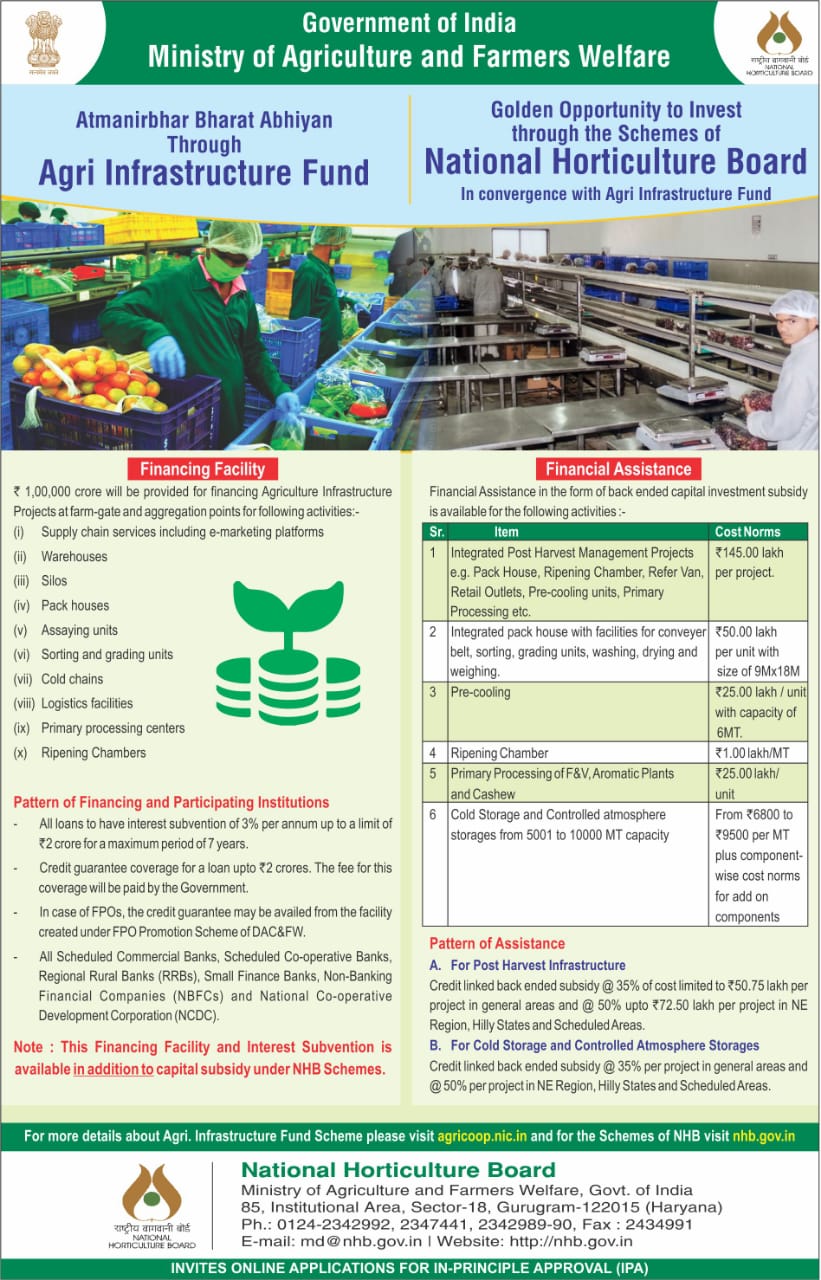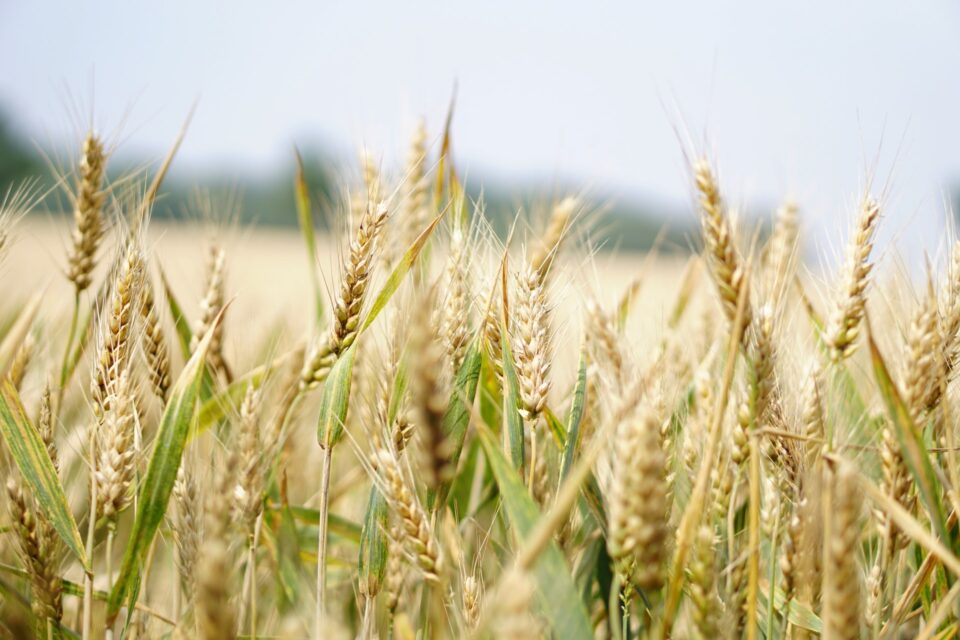Agriculture, together with its associated sectors, is indisputably India’s major source of income, primarily in the country’s vast rural areas. It also significantly contributes to the Gross Domestic Product (GDP) (GDP). Sustainable agriculture is critical for overall rural development in terms of food security, rural employment, and environmentally sustainable technologies such as soil conservation, sustainable natural resource management, and biodiversity protection. A green revolution, a white revolution, a yellow revolution, and a blue revolution have all happened in Indian agriculture and related activities.
In view of above, the Hon’ble Finance Minister announced on 15.05.2020, 1 lakh crore Agri Infrastructure Fund for farm-gate infrastructure for farmers. Financing facility of Rs. 1,00,000 crore will be provided for funding Agriculture Infrastructure Projects at farm-gate & aggregation points (Primary Agricultural Cooperative Societies, Farmers Producer Organizations, Agriculture entrepreneurs, Start-ups, etc.). Impetus for development of farm gate & aggregation point, affordable and financially viable Post Harvest Management infrastructure.
Agriculture Infrastructure Fund (National Agriculture Infra Financing Facility)
Launched in July 2020 by the Union Cabinet, this pan India Central Sector Scheme provides a medium – long term debt financing facility for investment in viable projects for post-harvest management Infrastructure and community farming assets through interest subvention and financial support.
Agriculture Infrastructure Fund will have numerous objective for all the stakeholders in the agriculture eco-system.
A. Farmers (including FPOs, PACS, Marketing Cooperative Societies, Multipurpose cooperative societies)
- Improved marketing infrastructure to allow farmers to sell directly to a larger base of consumers and hence, increase value realization for the farmers. This will improve the overall income of farmers.
- With investments in logistics infrastructure, farmers will be able to sell in the market with reduced post-harvest losses and a smaller number of intermediaries. This further will make farmers independent and improve access to market.
- With modern packaging and cold storage system access, farmers will be able to further decide when to sell in the market and improve realization.
- Community farming assets for improved productivity and optimization of inputs will result in substantial savings to farmers.
B. Government
- Government will be able to direct priority sector lending in the currently unviable projects by supporting through interest subvention, incentive and credit guarantee. This will initiate the cycle of innovation and private sector investment in agriculture.
- Due to improvements in post-harvest infrastructure, government will further be able to reduce national food wastage percentage thereby enable agriculture sector to become competitive with current global levels.
- Central/State Government Agencies or local bodies will be able to structure viable PPP projects for attracting investment in agriculture infrastructure.
C. Agri entrepreneurs and startups
- With a dedicated source of funding, entrepreneurs will push for innovation in agriculture sector by leveraging new age technologies including IoT, AI.
- It will also connect the players in ecosystem and hence, improve avenues for collaboration between entrepreneurs and farmers.
D. Banking ecosystem
- With Credit Guarantee, incentive and interest subvention lending institutions will be able to lend with a lower risk. This scheme will help to enlarge their customer base and diversification of portfolio.
- Refinance facility will enable larger role for cooperative banks and RRBs.
E. Consumers
- With reduced inefficiencies in post-harvest ecosystem, key benefit for consumers will be a larger share of produce reaching the market and hence, better quality and prices. Overall, the investment via the financing facility in agriculture infrastructure will benefit all the eco-system players.
Also Read : AI and the Future

Main Features
- Convergence with all schemes of central or state government.
- Online single window facility in collaboration with participating lending institutions.
- Project Management Unit to provide handholding support for projects including project preparation.
- Size of the financing facility – ₹ 1 lakh Crore.
- Credit Guarantee for loans up to ₹ 2 Crore.
- Interest subvention of 3% p.a., limited to ₹ 2 crore per project in one location, though loan amount can be higher.
- Cap on lending rate, so that benefit of interest subsidy reaches the beneficiary and services to farmers remain affordable.
- Multiple lending institutions including Commercial Banks, Cooperative Banks, RRBs, Small Finance Banks, NCDC, NBFCs etc.
- One eligible entity puts up projects in different locations then all such projects will be eligible under the scheme for loan upto ₹ 2 crore.
- For a private sector entity, such as farmer, agri entrepreneur, start-up there will be a limit of maximum of 25 such projects.
- Limitation of 25 projects will not be applicable to state agencies, national and state federations of cooperatives, federations of FPOs and federation of SHGs.
- Location mean physical boundary of a village or town having a distinct LGD (Local Government Directory) code.
- Each of such project should be in a location having a separate LGD (Local Government Directory) Code.
- APMCs will be eligible for multiple projects (of different infrastructure types) within their designated market area.
- Interest subvention will be available for a maximum period of 7 years.
- Moratorium for repayment under this financing facility may vary subject to minimum of 6 months and maximum of 2 years.
- Disbursement will complete in six years from 2020-21.
- Need based refinance support will be made available by NABARD to all eligible lending entities including cooperative banks and RRBs as per its policy.
Intended beneficiaries
- Agricultural Produce Market Committee
- Agri-Entrepreneur
- Central sponsored Public-Private Partnership Project
- Farmer
- Farmer Producers Organization
- Federation of Farmer Produce Organisations
- Joint Liability Groups
- Local Body sponsored Public-Private Partnership Project
- Marketing Cooperative Society
- Multipurpose Cooperative Society
- National Federations of Cooperatives
- Primary Agricultural Credit Society
- Self Help Group
- Federations of Self Help Groups
- Start-Up
- State Agencies
- State Federations of Cooperatives
- State sponsored Public-Private Partnership Project
How to apply
To apply online, click here.
Checklist of Documents
- Bank’s loan application form / Customer Request Letter for AIF Loan duly filled and signed
- Passport size photographs of the promoter/partners/director
- Identity proof – Voter ID card/PAN card/Aadhaar card/Driving license
- Address Proof :
- Residence: Voter ID card/Passport/Aadhaar card/Driving license/Electricity Bill/Latest property Tax Bill
- Business Office/Registered Office: Electricity Bill/Latest Property Tax Receipt/Certificate of Incorporation in case of Companies/Certificate of Registration in ca of partnership Firms
- Proof of Registration
- In case of Company : Article of Association
- In case of Partnership : Certificate of Registration of Firm with Registrar of Firm
- In case of MSMEs : Certificate of Registration with District Industries Centre (DIC)/Udyog Aadhar Copy
- Income Tax Return for last three years, If available.
- Audited Balance Sheet of last 3 Years, If available.
- GST Certificate, if applicable.
- Land ownership records – title deed/lease deed. If applicable, then Permission to mortgage the Immovable Property from the Lessor in case the Property is Leasehold (for primary security)
- ROC Search Report of the Company
- KYC documents of the promoter/firm/company
- Copy of Bank Statement for last one year (If available)
- Repayment track record of existing loans (Loan Statement)
- Net Worth Statements of promoter
- Detailed Project Report
- As applicable – Local authority permissions, Layout plans/estimates, Building sanction
To view the complete scheme guidelines, click here.
Source : National Agriculture Infra Financing Facility
Further Readings




